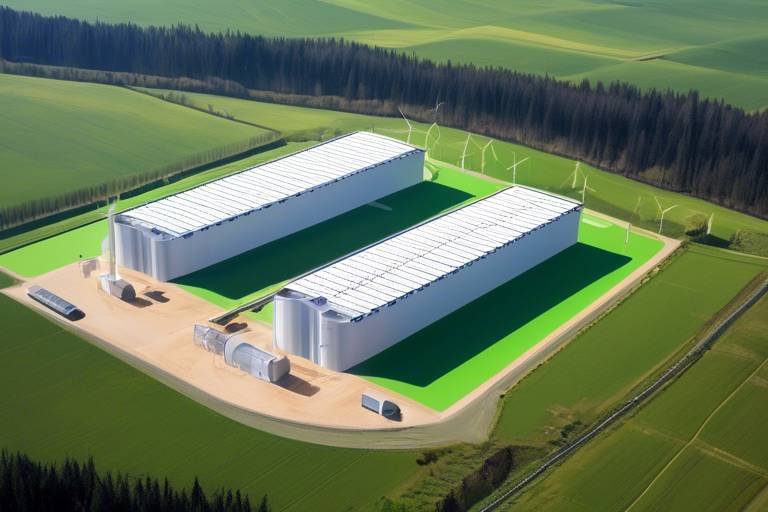The Latest Discoveries in Renewable Energy Materials
In a world increasingly driven by the need for sustainability, the latest discoveries in renewable energy materials are nothing short of revolutionary. These advancements are not just about harnessing energy; they are about redefining how we perceive and interact with our energy systems. Imagine a future where the sun, wind, and even waste can power our homes, vehicles, and industries without leaving a carbon footprint. This is the promise that cutting-edge materials bring to the table. As we delve deeper into this topic, we will explore the innovative technologies that are shaping the landscape of renewable energy, their applications, and the profound impact they have on our quest for a sustainable future.
One of the most exciting aspects of these discoveries is the rapid pace at which they are evolving. Researchers and engineers are pushing the boundaries of what is possible, creating materials that not only enhance energy efficiency but also reduce costs. For instance, advancements in solar cell technology have led to the development of perovskite materials, which are not only more efficient than traditional silicon-based cells but also cheaper to produce. This breakthrough could lead to a significant increase in solar energy adoption worldwide, making it a more accessible option for everyone.
Equally impressive are the innovations in wind energy materials. The evolution of lightweight and durable materials for wind turbine blades has transformed the sector, allowing for better energy capture and lower maintenance costs. This means that wind energy is becoming a more viable option for large-scale energy production, which is crucial for meeting global energy demands. The integration of composite materials in turbine design is a game changer, providing the necessary strength while minimizing weight, thus improving performance and longevity.
Moreover, the introduction of recyclable blade technologies addresses significant environmental concerns related to wind energy infrastructure. As we strive for sustainability, these innovations ensure that we can dispose of materials responsibly, reducing the ecological footprint of wind energy systems. Imagine a future where every part of a wind turbine can be recycled, contributing to a circular economy rather than ending up in landfills.
On the cutting edge of technology, smart materials are being integrated into wind turbines, enabling real-time monitoring and adaptive responses to environmental changes. This level of responsiveness optimizes energy production and enhances the efficiency of the entire system, making wind energy not only more reliable but also more intelligent.
As we look towards the future, the importance of next-generation storage solutions cannot be overstated. Research into advanced battery technologies and alternative storage methods is crucial for maximizing the efficiency of renewable energy systems. Without effective storage, the intermittent nature of renewable resources like solar and wind can lead to energy supply challenges. By developing materials that can store energy more efficiently, we can ensure a reliable energy supply that meets demand even when the sun isn't shining or the wind isn't blowing.
In addition to these technological advancements, the exploration of biomaterials derived from organic sources is opening new avenues for energy production. Algae-based biofuels, for instance, have emerged as a promising alternative due to their rapid growth and high lipid content. This could revolutionize the bioenergy sector, offering sustainable fuel options that help reduce our reliance on fossil fuels.
Furthermore, innovative waste-to-energy technologies are being developed to convert organic waste into usable energy. This not only aids in effective waste management but also contributes to renewable energy generation, promoting sustainability in a dual fashion. The potential of turning waste into energy is a perfect example of how we can tackle two pressing issues at once: waste disposal and energy production.
As we continue to innovate and explore emerging trends in energy efficiency, the focus remains on optimizing material usage and integrating renewable technologies into existing infrastructures. This approach is vital for reducing overall energy consumption and carbon emissions, paving the way for a greener future.
- What are renewable energy materials? Renewable energy materials are substances used to harness energy from renewable sources such as sunlight, wind, and organic materials.
- How do perovskite solar cells differ from traditional solar cells? Perovskite solar cells are more efficient and cheaper to produce compared to traditional silicon-based solar cells.
- What are the benefits of using smart materials in wind energy? Smart materials allow for real-time monitoring and adaptive responses, optimizing energy production and enhancing system efficiency.
- Can algae be a sustainable source of fuel? Yes, algae can be a sustainable source of biofuels due to their rapid growth and high lipid content.
- How do waste-to-energy technologies work? Waste-to-energy technologies convert organic waste into usable energy, effectively managing waste while generating renewable energy.

Advancements in Solar Cell Technology
In recent years, the world has witnessed a remarkable transformation in solar cell technology, driven by innovations that are not only enhancing efficiency but also reducing production costs. One of the most exciting breakthroughs is the development of perovskite solar cells. These materials have shown a tremendous increase in energy conversion efficiency, surpassing traditional silicon-based cells. Imagine a world where solar panels can generate more energy while taking up less space—this is becoming a reality thanks to perovskites!
The beauty of perovskite solar cells lies in their unique crystal structure, which allows them to absorb a wider spectrum of sunlight compared to conventional solar materials. This means they can convert more sunlight into electricity, making them an attractive option for both residential and commercial applications. In fact, recent studies have shown that these cells can achieve efficiencies exceeding 25%, a significant leap from previous technologies.
Moreover, the production process for perovskite solar cells is less energy-intensive and can be done using low-cost materials, which drastically lowers their overall manufacturing costs. This opens up opportunities for wider adoption across various markets, especially in developing countries where energy access is still a challenge. Just think about it: solar energy could become as ubiquitous as smartphones, empowering communities and reducing reliance on fossil fuels.
Another noteworthy advancement is the integration of bifacial solar panels. These panels can capture sunlight from both sides, increasing energy yield significantly. This is particularly beneficial in environments with reflective surfaces, such as snow or sand, where light bounces back and enhances energy capture. The versatility and efficiency of bifacial panels are revolutionizing the solar landscape, making solar energy even more appealing.
Furthermore, researchers are exploring the potential of transparent solar cells. These innovative cells can be applied to windows and other surfaces, turning ordinary structures into energy-generating assets. Imagine skyscrapers that not only house businesses but also produce clean energy while still allowing natural light to flood in. This could drastically change urban landscapes and contribute to a more sustainable future.
To summarize, the advancements in solar cell technology are paving the way for a brighter, greener future. With innovations like perovskite materials, bifacial panels, and transparent solar cells, we are on the brink of a solar revolution that could reshape our energy landscape. As these technologies continue to develop, they hold the promise of making solar energy more accessible, efficient, and sustainable for everyone.
| Type of Solar Cell | Efficiency (%) | Cost ($/W) |
|---|---|---|
| Traditional Silicon Cells | 15-22 | 0.50-0.70 |
| Perovskite Cells | 20-25+ | 0.20-0.30 |
| Bifacial Panels | 20-30 | 0.60-0.80 |
| Transparent Solar Cells | 10-15 | 0.80-1.00 |

Innovations in Wind Energy Materials
When we think about wind energy, we often picture those gigantic turbines spinning gracefully against the backdrop of a clear blue sky. But have you ever wondered what makes these towering structures so efficient? The answer lies in the innovative materials that are continually being developed to enhance their performance. Recent advancements have focused on creating lightweight, durable materials that not only improve energy capture but also significantly reduce maintenance costs. This is crucial, as the sustainability of wind energy hinges on its efficiency and cost-effectiveness.
One of the most exciting areas of innovation is the use of composite materials in turbine design. These materials, which combine two or more constituent materials to create a superior product, increase the strength of turbine blades while minimizing their weight. Imagine trying to lift a heavy object with one hand; it’s much easier if that object is lighter! Similarly, lighter turbine blades can rotate more easily and capture more wind energy, leading to enhanced performance and longevity of wind energy systems. The engineering behind these composites is fascinating, as it allows for designs that can withstand the harshest environmental conditions while still being efficient.
Composite materials, often made from a combination of fiberglass and carbon fiber, have become the backbone of modern wind turbine design. These materials are not only strong and lightweight but also resistant to corrosion and fatigue. This means that turbines can operate more efficiently over longer periods without the need for frequent repairs. In fact, some studies suggest that using advanced composites can improve energy output by up to 20% compared to traditional materials. It's akin to upgrading your old bicycle to a high-performance racing bike; the difference in speed and efficiency can be staggering!
As we strive for a more sustainable future, the environmental impact of wind energy infrastructure cannot be overlooked. That's where recyclable blade technologies come into play. Traditionally, turbine blades have been made from materials that are difficult to recycle, leading to significant waste at the end of their life cycle. However, recent innovations are focusing on creating blades from recyclable materials that can be repurposed rather than ending up in landfills. This not only addresses environmental concerns but also promotes a circular economy in the wind energy sector.
Another groundbreaking development in wind energy materials is the integration of smart materials. These materials can adapt to changing environmental conditions, allowing turbines to optimize their performance in real-time. For example, smart materials can change their stiffness based on wind speed, ensuring that turbines operate efficiently regardless of weather conditions. This is like having a pair of shoes that adjusts to your foot size and the surface you're walking on, providing comfort and stability no matter where you go. By harnessing the power of smart materials, we can ensure that wind energy remains a reliable and efficient source of power.
In conclusion, the innovations in wind energy materials are not just technical advancements; they represent a significant leap towards a more sustainable and efficient energy future. As these technologies continue to evolve, we can expect to see wind energy becoming an even more viable option for large-scale energy production. The future of energy is indeed bright, and it’s being powered by the winds of change!
- What are composite materials? Composite materials are made from two or more different materials that, when combined, create a product with superior properties, such as strength and lightweight characteristics.
- How do smart materials work in wind turbines? Smart materials can respond to environmental changes, altering their properties to optimize turbine performance based on real-time conditions.
- Why is recycling important in wind energy? Recycling helps reduce waste and environmental impact, allowing for a more sustainable lifecycle for wind energy infrastructure.

Composite Materials for Turbines
In the quest for more efficient and sustainable energy solutions, the use of composite materials in wind turbine design has emerged as a game-changer. These materials, often made from a combination of fibers and resins, offer a unique blend of strength and lightweight properties that are crucial for modern wind energy systems. Imagine trying to lift a heavy object with one hand; it’s not just difficult, it’s nearly impossible. Now, picture that same object being feather-light. This is the kind of transformation composite materials bring to the table, allowing turbines to harness wind energy more effectively.
One of the standout features of composite materials is their ability to withstand harsh environmental conditions. Wind turbines are often placed in remote locations where they face extreme weather, from high winds to icy conditions. Traditional materials struggle under these circumstances, but composites are designed to endure. They resist corrosion and fatigue, which means less downtime for maintenance and more energy production. In fact, studies show that turbines made with advanced composites can last up to 25% longer than those made from conventional materials, significantly enhancing the return on investment for wind farm operators.
Additionally, the manufacturing process of composite materials allows for greater design flexibility. Engineers can create blades that are not only longer but also more aerodynamically efficient. This is akin to how a bird’s wing is shaped to optimize flight. Longer blades capture more wind, leading to increased energy output. To illustrate this point, consider the following table that compares traditional turbine materials with composite materials:
| Feature | Traditional Materials | Composite Materials |
|---|---|---|
| Weight | Heavy | Lightweight |
| Durability | Less durable | Highly durable |
| Maintenance | Frequent maintenance required | Reduced maintenance |
| Design Flexibility | Limited | Highly flexible |
Moreover, the future of composite materials looks promising with ongoing research aimed at enhancing their properties even further. Innovations such as bio-based composites are being explored, which not only improve sustainability but also reduce the carbon footprint associated with turbine production. By using renewable resources in composites, we can create a circular economy that benefits both the environment and the energy sector.
In conclusion, the adoption of composite materials in wind turbine design is not just a trend; it’s a necessary evolution for the renewable energy industry. The combination of lightweight structures, increased durability, and design flexibility positions these materials as a cornerstone for future developments in wind energy. As we continue to innovate and push the boundaries of technology, the potential for wind energy will only grow, making it an integral part of our sustainable future.
- What are composite materials? Composite materials are made from two or more constituent materials with significantly different physical or chemical properties. They are engineered to provide enhanced performance.
- Why are composite materials used in wind turbines? They offer a combination of lightweight, strength, and durability, which are essential for maximizing energy capture and minimizing maintenance costs.
- How do composite materials improve turbine efficiency? By allowing for longer and more aerodynamically designed blades, composite materials increase the amount of wind captured, thus improving overall energy output.
- Are there any environmental benefits to using composites? Yes, many composite materials can be made from renewable resources, and their durability reduces the frequency of replacements, leading to less waste.

Recyclable Blade Technologies
As the world pivots towards sustainable energy solutions, the focus has increasingly turned to in wind energy. Traditional wind turbine blades, often made from composite materials, pose significant environmental challenges at the end of their lifecycle. These blades can take decades to decompose, contributing to landfill waste and environmental degradation. Thankfully, innovative advancements in material science are paving the way for blades that can be recycled, reducing their ecological footprint and promoting a circular economy.
One of the most exciting developments in this field is the use of thermoplastic composites. Unlike traditional thermosetting composites, which harden permanently, thermoplastics can be reshaped and reused. This characteristic not only allows for easier recycling of the materials but also enables manufacturers to create blades that can be efficiently produced and repaired. Imagine a world where wind turbine blades can be melted down and reformed into new products – this is the future that recyclable blade technologies promise.
Additionally, some companies are exploring the use of bio-based materials for turbine blades. These materials, derived from renewable resources, offer a sustainable alternative to conventional composites. They not only reduce reliance on fossil fuels but also enhance the recyclability of the blades. For instance, blades made from natural fibers can be composted at the end of their life cycle, returning nutrients to the earth instead of contributing to waste.
Moreover, the integration of smart recycling processes plays a crucial role in this innovation. Advanced technologies are being developed to efficiently dismantle old blades and separate their components for recycling. This process not only minimizes waste but also maximizes the recovery of valuable materials, thus enhancing the overall sustainability of wind energy systems. As these technologies become more widespread, we can expect a significant reduction in the environmental impact of wind energy infrastructure.
In conclusion, recyclable blade technologies represent a significant leap forward for the wind energy industry. By embracing materials that can be reused and recycled, we are not just addressing the waste generated by old turbine blades; we are also setting a precedent for future innovations in renewable energy. The shift towards sustainable materials in wind energy not only supports environmental goals but also drives economic benefits, creating jobs in recycling and material science sectors. It’s a win-win situation that highlights the importance of sustainability in our quest for clean energy solutions.
- What are recyclable blade technologies?
Recyclable blade technologies refer to the advancements in material science that allow wind turbine blades to be made from materials that can be recycled or reused at the end of their lifecycle. - Why are traditional wind turbine blades a problem?
Traditional blades are often made from composite materials that do not decompose easily, leading to significant waste and environmental issues when they are decommissioned. - How do thermoplastic composites work?
Thermoplastic composites can be reshaped and reused, making them easier to recycle compared to traditional thermosetting composites, which harden permanently. - What are the benefits of using bio-based materials?
Bio-based materials reduce reliance on fossil fuels and enhance recyclability, as they can often be composted at the end of their lifecycle. - How does smart recycling technology improve sustainability?
Smart recycling technologies streamline the dismantling and recycling process, maximizing material recovery and minimizing waste, thus contributing to a more sustainable approach to wind energy.

Smart Materials in Wind Energy
In the ever-evolving landscape of renewable energy, smart materials are emerging as game-changers, particularly in the field of wind energy. These materials are not just passive components; they possess the ability to sense and respond to environmental stimuli, making them incredibly valuable in optimizing wind turbine performance. Imagine a wind turbine that can "feel" the wind speed and direction, adjusting its blades in real-time to maximize energy capture. This is the magic of smart materials!
One of the most exciting aspects of smart materials is their ability to enhance the efficiency and reliability of wind turbines. For instance, materials embedded with sensors can monitor structural integrity and detect fatigue in blades before they fail. This proactive approach to maintenance can significantly reduce downtime and maintenance costs, leading to a more sustainable and economically viable energy source.
Moreover, smart materials can adapt to changing environmental conditions. For example, piezoelectric materials can convert mechanical stress from wind forces into electrical energy, which can be utilized to power onboard systems or sensors. This self-sustaining capability not only reduces the need for external power sources but also enhances the overall efficiency of wind energy systems.
To illustrate the potential of smart materials in wind energy, consider the following table that outlines some of the key features and benefits:
| Smart Material | Key Features | Benefits |
|---|---|---|
| Piezoelectric Materials | Generate electricity from mechanical stress | Self-powering systems, reduced energy loss |
| Shape Memory Alloys | Change shape in response to temperature | Adaptive blade design, improved aerodynamics |
| Self-healing Polymers | Repair damage autonomously | Increased lifespan, reduced maintenance costs |
As we look to the future, the integration of smart materials in wind energy systems holds immense potential. These innovations not only promise to enhance the efficiency and durability of wind turbines but also contribute to the broader goal of sustainability. By harnessing the power of smart materials, we can create wind energy solutions that are not only more effective but also more environmentally friendly.
In conclusion, the rise of smart materials in wind energy is akin to adding a brain to a brawn-powered machine. It's about making our energy systems smarter, more responsive, and ultimately more capable of meeting the demands of a sustainable future. As we continue to explore these advancements, it's clear that the wind energy sector is on the brink of a technological revolution that could redefine how we harness nature's power.
- What are smart materials? Smart materials are materials that can sense and respond to environmental changes, enhancing the functionality of various systems.
- How do smart materials improve wind energy systems? They optimize performance by enabling real-time adjustments, monitoring structural integrity, and increasing overall efficiency.
- What are some examples of smart materials used in wind energy? Examples include piezoelectric materials, shape memory alloys, and self-healing polymers.

Next-Generation Storage Solutions
As we dive deeper into the world of renewable energy, one of the most pressing challenges we face is how to store this energy efficiently. Imagine trying to fill a bucket with water, but the bucket has holes. That’s how our current energy systems often feel when it comes to storing renewable energy. This is where come into play. They promise to revolutionize the way we harness and utilize renewable energy, ensuring that we can use it when we need it most, not just when the sun is shining or the wind is blowing.
Recent research has focused on advanced battery technologies, particularly lithium-sulfur and solid-state batteries. These innovations offer higher energy densities and longer lifespans compared to traditional lithium-ion batteries. For instance, lithium-sulfur batteries can potentially deliver up to five times the energy capacity, which could drastically reduce the size and weight of energy storage systems. Imagine the possibilities if electric vehicles could travel much farther on a single charge!
Another exciting development is the use of alternative storage methods. Pumped hydro storage has been a reliable method for decades, but it’s not the only game in town anymore. Emerging technologies such as compressed air energy storage (CAES) and flywheel energy storage are gaining traction. These systems store energy in different forms—like compressed air or kinetic energy—then convert it back to electricity when needed. The flexibility of these systems can help stabilize the grid and manage energy supply effectively.
Moreover, integrating these advanced storage solutions with renewable energy sources can significantly enhance energy efficiency. For example, pairing solar panels with battery storage allows homeowners to store excess energy generated during the day for use at night. This not only maximizes energy usage but also reduces dependence on fossil fuels and lowers electricity bills. In commercial settings, businesses can store energy during off-peak hours and use it during peak demand, leading to substantial cost savings.
To illustrate the impact of these technologies, consider the following table that compares traditional energy storage methods with next-generation solutions:
| Storage Method | Energy Density (Wh/kg) | Cycle Life | Environmental Impact |
|---|---|---|---|
| Lithium-Ion | 150-200 | 500-1500 cycles | Moderate |
| Lithium-Sulfur | 400-600 | 300-500 cycles | Lower |
| Solid-State | 300-500 | 2000+ cycles | Low |
| Compressed Air | 20-40 | Unlimited | Moderate |
| Flywheel | 20-40 | 20,000+ cycles | Low |
As we can see, next-generation storage solutions not only offer improved energy densities and longer cycle lives but also tend to have a lower environmental impact compared to traditional methods. This is crucial as we strive for a more sustainable future. The integration of these technologies into our energy systems could lead to a significant reduction in carbon emissions, contributing to global efforts to combat climate change.
In summary, next-generation storage solutions are at the forefront of the renewable energy revolution. They hold the key to unlocking the full potential of solar, wind, and other renewable sources, ensuring that we can store and use energy efficiently. As these technologies continue to develop and become more accessible, we can look forward to a future where energy is abundant, clean, and sustainable.
- What are next-generation storage solutions? These are advanced technologies designed to store renewable energy more efficiently, including lithium-sulfur batteries, solid-state batteries, and alternative storage methods like compressed air and flywheels.
- How do these solutions improve energy efficiency? They allow for energy to be stored when production exceeds demand and used during peak times, reducing reliance on fossil fuels and optimizing energy use.
- What is the environmental impact of these technologies? Many next-generation storage solutions have a lower environmental impact compared to traditional methods, contributing to sustainability and reducing carbon emissions.

Biomaterials for Energy Production
In the quest for sustainable energy solutions, biomaterials derived from organic sources are emerging as powerful alternatives to traditional fossil fuels. These materials not only contribute to energy production but also play a crucial role in promoting a circular economy. Imagine harnessing the power of nature itself to fuel our energy needs—this is precisely what biomaterials aim to achieve. By utilizing resources that are renewable and often waste products, we can significantly reduce our carbon footprint while ensuring a more sustainable future.
One of the most exciting developments in this field is the exploration of algae-based biofuels. Algae are remarkable organisms that can grow in a variety of environments, including saltwater and wastewater, making them an incredibly versatile resource. They have a high lipid content, which can be converted into biodiesel, offering a sustainable fuel option that does not compete with food crops. In fact, algae can produce up to 30 times more oil per acre than traditional oilseed crops. This means that as we look to the future, algae could very well revolutionize the bioenergy sector.
Moreover, the process of cultivating algae is relatively low-impact. Unlike conventional crops, algae require minimal land use and can thrive in environments unsuitable for agriculture. This opens up a world of possibilities for energy production without sacrificing valuable arable land. Additionally, algae absorb carbon dioxide as they grow, effectively acting as a carbon sink and helping to mitigate climate change.
Another innovative approach in the realm of biomaterials is the development of waste-to-energy technologies. These processes convert organic waste—such as food scraps and agricultural residues—into usable energy. Not only does this provide a renewable energy source, but it also addresses the growing problem of waste management. By converting waste into energy, we tackle two pressing issues simultaneously: reducing landfill use and generating clean energy.
For instance, anaerobic digestion is a widely used method in waste-to-energy systems. In this process, microorganisms break down organic matter in the absence of oxygen, producing biogas, which can be used for heating, electricity generation, or even as a vehicle fuel. The remaining material, called digestate, can be repurposed as a nutrient-rich fertilizer, thus completing the cycle of sustainability.
The potential of biomaterials in energy production is vast, but it is essential to approach their development responsibly. As we innovate, we must ensure that these processes do not lead to unintended consequences, such as biodiversity loss or competition with food production. By prioritizing sustainability and ethical practices, we can harness the power of biomaterials to create a cleaner, greener future.
- What are biomaterials? Biomaterials are materials derived from natural sources that can be used for energy production, such as algae and organic waste.
- How do algae-based biofuels work? Algae can be cultivated to produce oils that are then converted into biodiesel, providing a sustainable fuel alternative.
- What is waste-to-energy technology? Waste-to-energy technology involves converting organic waste into usable energy, addressing both waste management and renewable energy generation.
- Are biomaterials sustainable? Yes, when developed responsibly, biomaterials can significantly reduce carbon emissions and promote a circular economy.

Algae-Based Biofuels
When we think about the future of energy, one of the most exciting frontiers is . Imagine a world where our energy sources are not only renewable but also sustainable and environmentally friendly. Algae, those tiny green organisms that often float in ponds, possess an incredible potential for producing biofuels. Why? Because they can grow rapidly and are rich in lipids, which can be converted into biodiesel. This is a game changer in the quest for cleaner energy sources.
Unlike traditional crops that require vast amounts of land, water, and fertilizers, algae can thrive in a variety of environments, including saltwater and wastewater. This adaptability means that we can produce biofuels without competing for valuable agricultural land, thus preserving our food supply. In fact, studies show that algae can produce up to 30 times more oil per acre than conventional crops like soybeans or corn. Isn't that mind-blowing?
Moreover, the process of cultivating algae for biofuels can actually help in carbon dioxide sequestration. Algae absorb CO2 from the atmosphere, using it as a nutrient to grow. This means that the more we produce algae, the more we can help mitigate climate change by reducing greenhouse gas emissions. It's a win-win situation!
Now, let's talk about the process of converting algae into biofuels. The general steps include:
- Harvesting: Algae are collected from their growth medium.
- Extracting Oils: The lipids are extracted from the algae through various methods, including mechanical pressing or solvent extraction.
- Transesterification: The extracted oils are then converted into biodiesel through a chemical reaction with an alcohol.
- Refining: Finally, the biodiesel is refined to meet fuel standards.
This entire process is not only efficient but also scalable. Researchers are continually improving the technology, making it more cost-effective and accessible. Companies around the world are investing in algae biofuel production, and pilot projects are already underway, demonstrating its viability as a sustainable energy source.
While there are challenges to overcome, such as reducing production costs and increasing yield, the future of algae-based biofuels looks promising. With ongoing research and innovation, we could see algae playing a crucial role in our energy landscape within the next few decades. Imagine driving your car on fuel derived from algae or powering your home with energy sourced from these tiny organisms!
1. What are algae-based biofuels?
Algae-based biofuels are renewable energy sources derived from algae, which can be converted into biodiesel or other fuels. They are considered sustainable due to the rapid growth rate of algae and their ability to absorb carbon dioxide.
2. How do algae produce energy?
Algae produce energy through photosynthesis, where they convert sunlight, carbon dioxide, and nutrients into biomass and oils that can be transformed into biofuels.
3. Are algae biofuels environmentally friendly?
Yes, algae biofuels are environmentally friendly as they can help reduce greenhouse gas emissions and do not compete with food crops for land and resources.
4. What are the challenges of producing algae-based biofuels?
Some challenges include high production costs, the need for efficient harvesting and extraction methods, and scaling up production to meet energy demands.

Waste-to-Energy Technologies
In our quest for sustainable energy solutions, have emerged as a beacon of hope, transforming what was once considered trash into valuable energy resources. Imagine your daily garbage being converted into electricity or heat—sounds like something out of a sci-fi movie, right? But this is the reality we are moving towards, and it's exciting!
At its core, waste-to-energy (WtE) technology involves the process of converting non-recyclable waste materials into usable forms of energy, including electricity, heat, or fuel. This not only helps in managing waste effectively but also contributes to reducing our reliance on fossil fuels. The process typically involves several stages, including combustion, gasification, and anaerobic digestion. Each method has its unique advantages and applications, making WtE a versatile solution in the renewable energy landscape.
One of the most common methods is combustion, where waste materials are burned at high temperatures to produce steam that drives turbines for electricity generation. This process can significantly reduce the volume of waste, with some facilities achieving up to 90% volume reduction. However, it's essential to manage emissions from this process carefully to minimize environmental impact.
Gasification, on the other hand, is a more advanced technique that converts organic or fossil-based materials into carbon monoxide, hydrogen, and carbon dioxide. This syngas can then be used to produce electricity or as a building block for synthetic fuels. The beauty of gasification lies in its ability to handle a diverse range of feedstocks, from municipal solid waste to agricultural residues.
Another fascinating method is anaerobic digestion, where microorganisms break down organic matter in the absence of oxygen. This process produces biogas, primarily composed of methane, which can be used for heating or electricity generation. Not only does this technology help in waste management, but it also provides a renewable energy source that can power homes and businesses.
The benefits of waste-to-energy technologies extend beyond energy production. They play a crucial role in promoting a circular economy by reducing landfill use and minimizing greenhouse gas emissions. By diverting waste from landfills, we can significantly lower methane emissions, a potent greenhouse gas that contributes to climate change.
To illustrate the impact of WtE technologies, consider the following table that summarizes key benefits:
| Benefit | Description |
|---|---|
| Waste Reduction | Reduces the volume of waste sent to landfills. |
| Energy Production | Generates renewable energy from waste materials. |
| Greenhouse Gas Reduction | Decreases methane emissions from landfills. |
| Resource Recovery | Recovers valuable materials and energy from waste. |
However, it's worth noting that the implementation of waste-to-energy technologies is not without challenges. Public perception and regulatory hurdles can slow down the adoption of these systems. Many communities are concerned about the potential emissions and health impacts associated with waste incineration. Therefore, it's crucial to engage with local populations and stakeholders, ensuring that they understand the benefits and safety measures associated with these technologies.
In conclusion, waste-to-energy technologies represent a promising pathway toward a more sustainable future, effectively addressing two critical issues: waste management and energy production. As we continue to innovate and improve these systems, we can look forward to a world where our waste no longer goes to waste but instead becomes a valuable resource.
- What is waste-to-energy technology? Waste-to-energy technology converts non-recyclable waste into usable energy forms, such as electricity or heat.
- How does combustion work in waste-to-energy? Combustion involves burning waste at high temperatures to produce steam that drives turbines for electricity generation.
- What are the environmental benefits of waste-to-energy? It reduces landfill waste, lowers greenhouse gas emissions, and contributes to energy production.
- Is waste-to-energy safe? Yes, with proper technology and regulation, waste-to-energy can be safe and environmentally friendly.

Emerging Trends in Energy Efficiency
As we dive deeper into the 21st century, the quest for energy efficiency has never been more critical. With the world grappling with climate change and the urgent need to reduce carbon emissions, innovative approaches are emerging that promise to transform how we consume energy. One of the most exciting trends is the integration of renewable technologies into existing infrastructures. Imagine your home or office not just consuming energy, but generating it! This shift not only reduces reliance on non-renewable sources but also enhances the overall efficiency of energy systems.
Another fascinating trend is the optimization of material usage in construction and manufacturing. By utilizing smart materials, buildings can adapt to their environment, adjusting lighting and heating based on occupancy and weather conditions. This adaptability not only cuts energy costs but also creates a more comfortable living space. For instance, consider a building that can automatically adjust its blinds based on sunlight intensity. This simple yet effective measure can drastically reduce the need for artificial lighting and cooling.
Moreover, the rise of energy management systems (EMS) is revolutionizing how businesses and homeowners monitor and control their energy consumption. These systems use real-time data analytics to provide insights into energy usage patterns, helping users identify opportunities for savings. For example, a small business can track its energy consumption throughout the day and adjust operations to minimize peak usage, ultimately leading to lower energy bills.
In addition to these technological advancements, consumer behavior is also shifting towards sustainability. People are becoming more conscious of their energy consumption, seeking out energy-efficient appliances and practices. This growing awareness is driving manufacturers to innovate and create products that not only meet energy efficiency standards but exceed them. For instance, the latest models of refrigerators and washing machines are designed to consume significantly less energy while maintaining optimal performance.
To further illustrate the impact of these trends, consider the following table that highlights the potential energy savings from adopting energy-efficient technologies:
| Technology | Average Energy Savings (%) | Environmental Impact |
|---|---|---|
| Smart Thermostats | 10-20% | Reduces carbon footprint |
| LED Lighting | 75-80% | Less waste and longer lifespan |
| Energy Star Appliances | 10-50% | Lower greenhouse gas emissions |
| Insulation Upgrades | 20-30% | Improved energy retention |
As we look ahead, the future of energy efficiency is bright, driven by innovation and a collective commitment to sustainability. The combination of advanced technologies, smart materials, and a shift in consumer behavior is paving the way for a more energy-efficient world. But it doesn’t stop there; collaboration between governments, industries, and individuals is essential to maximize these advancements and ensure a sustainable future for generations to come.
- What are the benefits of energy efficiency? Energy efficiency reduces energy costs, lowers greenhouse gas emissions, and enhances the comfort of living and working spaces.
- How can I improve energy efficiency in my home? You can improve energy efficiency by using energy-efficient appliances, upgrading insulation, and installing smart thermostats.
- What role do renewable technologies play in energy efficiency? Renewable technologies reduce dependence on fossil fuels and can be integrated into existing systems to enhance overall energy efficiency.
- Are there incentives for adopting energy-efficient technologies? Yes, many governments offer tax credits, rebates, and other incentives to encourage the adoption of energy-efficient technologies.
Frequently Asked Questions
- What are perovskite solar cells and why are they important?
Perovskite solar cells are a new type of solar technology that utilizes a unique crystal structure to absorb sunlight more efficiently than traditional silicon-based cells. Their importance lies in their potential to significantly lower production costs while increasing energy conversion efficiency, making solar energy more accessible and affordable for everyone.
- How do lightweight materials enhance wind turbine performance?
Lightweight materials, such as advanced composites, play a crucial role in wind turbine design by allowing for larger blades without adding excessive weight. This design innovation improves energy capture and reduces wear and tear, leading to lower maintenance costs and longer lifespans for turbines, making wind energy a more sustainable option.
- What are recyclable blade technologies in wind energy?
Recyclable blade technologies refer to the development of wind turbine blades that can be repurposed or recycled at the end of their lifecycle. This innovation addresses environmental concerns related to waste generated by traditional blades, promoting sustainability and reducing the ecological footprint of wind energy infrastructure.
- How do smart materials contribute to wind energy efficiency?
Smart materials in wind turbines enable real-time monitoring and adaptive responses to changing environmental conditions. This means that turbines can optimize their performance based on wind speed and direction, leading to improved energy production and operational efficiency.
- What advancements are being made in energy storage solutions?
Research into advanced battery technologies and alternative storage methods, such as pumped hydro or compressed air, is crucial for maximizing the efficiency of renewable energy systems. These innovations help ensure a reliable energy supply, especially when production fluctuates due to weather conditions.
- How do algae-based biofuels work?
Algae-based biofuels are produced from the lipids found in algae, which can grow rapidly and thrive in various environments. This makes them a sustainable alternative to traditional fossil fuels, as they can be cultivated without competing for arable land and can potentially produce more energy per acre than conventional crops.
- What are waste-to-energy technologies?
Waste-to-energy technologies convert organic waste into usable energy, such as electricity or heat. This dual benefit not only helps in waste management but also contributes to renewable energy generation, promoting sustainability and reducing landfill use.
- What emerging trends are shaping energy efficiency?
Emerging trends in energy efficiency focus on optimizing material usage and integrating renewable technologies into existing infrastructures. These practices aim to reduce overall energy consumption and carbon emissions, paving the way for a more sustainable future.



















